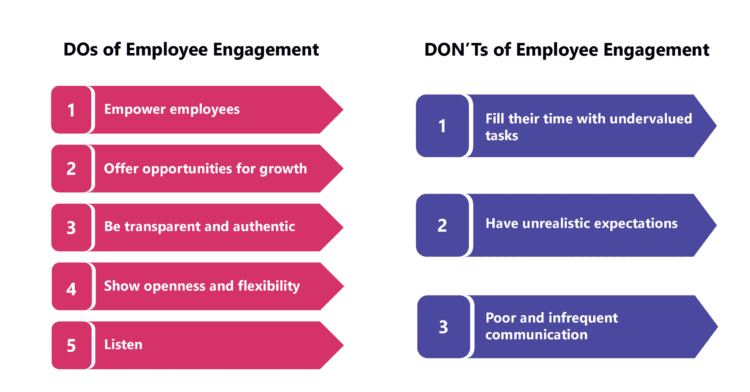DOs:
1. Empower Employees: Give them control and decision-making power to enhance motivation and ownership.
2. Offer Growth Opportunities: Provide avenues for professional development and career progression to boost loyalty and engagement.
3. Be Transparent and Authentic: Build trust through open, honest communication and keep employees informed about relevant business matters.
4. Show Openness and Flexibility: Adopt flexible policies to increase employee satisfaction and engagement.
5. Listen: Actively seek employees’ ideas and concerns to make them feel valued and engaged.
DON’Ts
1. Avoid Undervalued Tasks: Do not assign tasks below employees’ skill levels or consider them meaningless, as this lowers engagement and self-worth.
2. Avoid Unrealistic Expectations: Setting unattainable goals leads to frustration and disengagement.
3. Avoid Poor Communication: Lack of clear and regular communication fosters distrust and confusion, reducing employee motivation and productivity.
A highly engaged workforce provides numerous benefits for organizations, such as higher productivity, better talent retention, and improved client relationships. However, organizations must adequately develop employee engagement strategies to gain these benefits. Here are the Dos and Don’ts of Employee Engagement:
| DOs | DON’Ts |
| 1. Empower employees | 1. Fill their time with undervalued tasks |
| 2. Offer opportunities for growth | 2. Have unrealistic expectations |
| 3. Be transparent and authentic | 3. Poor and infrequent communication |
| 4. Show openness and flexibility | |
| 5. Listen |


Empowering employees to make strategic decisions about their work enhances their sense of control and ownership.
They feel more trusted and generally makes them enjoy the tasks being assigned to them. Even when the employees are empowered within set boundaries,
they feel motivated to give their best and prove their worth to their superiors.
They are also more willing to help and support their co-workers and improve the work environment.

Most employees seek professional and personal growth opportunities within their current organization.
They want opportunities to showcase and enhance their skills through peer support and supervisor guidance.
Hence, managers need to know and guide the employees in their teams to progress on the desired career paths through relevant assignments, training, and development opportunities.
Realizing that the organization is making a significant effort to promote its career enhances employee loyalty and engagement.

One of the most basic requirements for building an engaged workforce is to create an environment of trust.
For this, the organization must develop a positive relationship with the workforce members.
They need to be open, honest, and transparent with the employees and keep them updated about business policies and processes that may impact them directly or indirectly.
Such an approach is essential for boosting employee engagement by making them feel like an integral part of the organization.

Employees tend to be less engaged if they believe the organization’s policies to be too rigid and restrictive.
That is why organizations today need to adopt a more open and flexible approach while designing their policies.
It creates a sense of satisfaction among the employees and enhances their happiness quotient at the workplace.
Thus, they feel more inclined to become positively involved in the organization’s work and ensure their optimum contribution to its growth.

Managers ‘ inability to listen to employees ‘ opinions is another key factor that can lead to lower employee engagement.
Hearing out their views, ideas, and perspectives assures the employees of being truly valued.
Their sense of self-worth gets boosted when they can voice their opinions and contribute to creating a better workplace.
So, listening to the employees is essential to keeping them engaged.

Assigning tasks that hold little value for the organization can make the employees feel like they are a burden.
Tasks assigned such as creating mundane reports that no one reads, or handling tasks that are way below their skill set, can impact their sense of self-worth in a deeply negative manner.
It can also cause them to doubt their usefulness to the organization and even destroy their sense of belonging, leading to low engagement and reduced productivity.

Employees tend to become disengaged from their organizations due to the unrealistic expectations of the organization.
Such expectations make the employees feel like they are being deliberately set up for failure.
Unrealistic expectations ensure that employees always fall short of being successful in completing their tasks despite putting in their best efforts.
Consequently, they end up losing interest, and their morale drops significantly.

Lack of frank and regular communication often breeds distrust within the workforce.
Hence, employees feel confused about their roles and responsibilities, significantly affecting their performance.
Overall, poor and infrequent communication affects employee motivation and engagement, leading to a loss of productivity.
Developing strategies with clear DOs and DON’Ts of employee engagement can help in making the members of the workforce feel motivated and involved within their organization.
It can, in turn, improve collaboration and productivity among employees, leading to better business results.

Lead author: Sagar Chaudhuri, the Co-Founder and CEO of HiFives. He is an HR Tech Evangelist with over 25 years of corporate and entrepreneurship experience. In the past, Sagar has worked in leadership roles with companies such as Genpact, Infosys, and ICICI Bank. He has an engineering degree from IIT Kharagpur and an MBA from IIM Lucknow. Connect on LinkedIn
To stay updated on the latest HiFives blogs, follow us on Twitter (@MyHiFives)